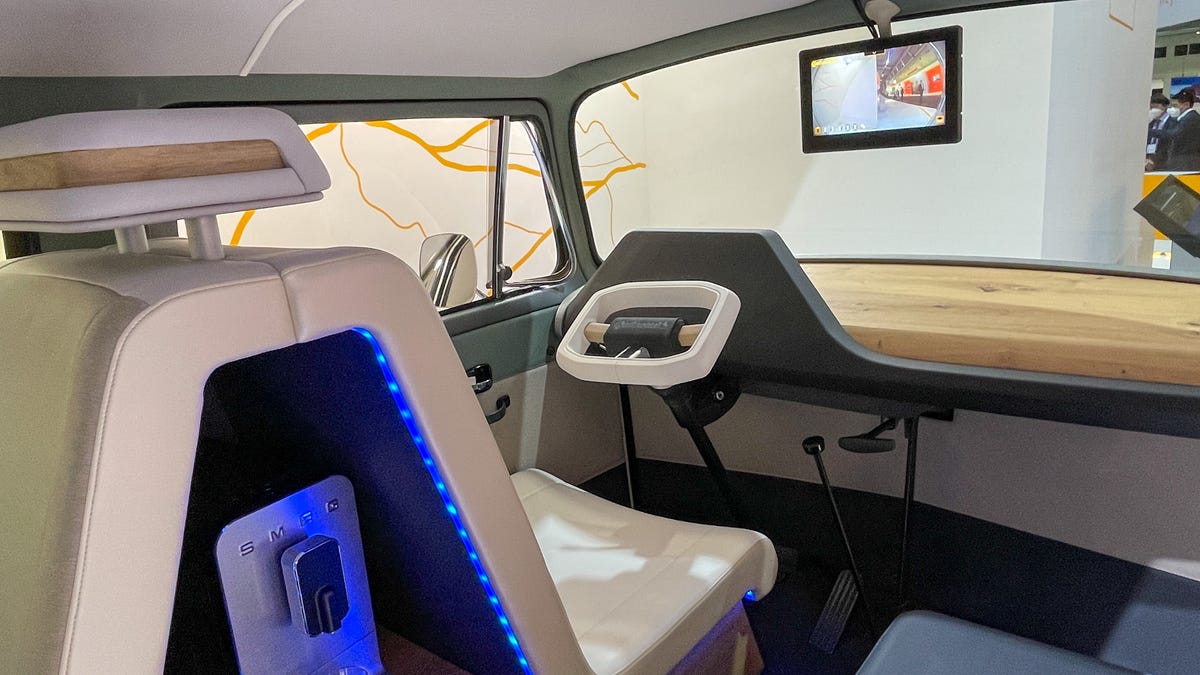Why your next cars might have heated floors and ceilings
Continental is using a classic VW bus to show off how it plans to make your interior cozier -- and more efficient.
We've had heated seats in cars for decades, and more recently, heated armrests in select high-end luxury automobiles like the Mercedes-Benz S-Class. But what about warming other surfaces to control the temperature of an entire interior? That's one of the technologies that German supplier Continental is previewing in its new Ambienc3 concept van. Based on a 50-year-old version of Volkswagen's instantly recognizable Microbus, this vehicle is a rolling showcase for a number of different cabin surface technologies including lighting, speakerless audio and heating that combine to create an inviting, lounge-like space. There's even a coffee maker. The retro-bodied concept debuted Monday at the IAA Munich Motor Show where I got the chance to check it out firsthand.
Among other things, the Ambienc3 is loaded with sustainable fabrics, including the aforementioned heated materials that don't rely on a separate warming element between the upholstery and cushion foams. Instead, Continental can actually print the heating elements directly on the underside of the upholstery itself using a proprietary process. Ralph Imbery, Continental's global director of design, marketing and digitalization, tells me this tech is "10 times faster than a normal heating system, and you need a lot less energy because it's directly on the material." What's more, Imbery says, "You could also could heat the ceiling -- the headliner -- and also have some zones in the front where you heat the [occupants'] knees, or legs, or their sides." Floors, door panels, dashboards, it's all possible.
Of course, all but the most basic cars would likely still require a traditional forced-air system for cooling and ventilation, but Imbery specifically cites this technology as being of particular benefit in electric vehicles where the power draw and weight of conventional forced-air systems is felt most acutely in the form of lower driving range. It's possible that adding a number of heated surfaces to an EV's cabin could allow for a lighter, smaller-capacity and less-power-hungry HVAC system to be fitted while still preserving passenger comfort.
As a concept, the Ambienc3 does without a traditional climate control system entirely. Instead, the concept employs new, more breathable and sustainable upholstery. Imbery calls these "passive-climate seats," noting that the fabrics help keep occupants cool in tandem with the VW's prototype electrochromic window glass that can vary light opacity on demand via remote control.
Are these heated floors and headliners just concept-car frippery? Not at all, says Imbery. "We already have orders for it [the technology]. Absolutely in two years it will be in serial production, you can see it on the road," he said. According to the German executive, this tech will first surface in vehicles from a "big, premium customer." When I specifically asked Imbery if that automaker might be BMW, he gestured and said, "One of them."
So, what is it about Volkswagen's classic microvan that lends itself to future-technology retrofits like this? In 2019, VW itself showed off its Type 20 Concept, a 1962 Type 2 Bus converted to run on electricity, and more recently, I drove a 1963 Samba and contemplated what VW will need to make its upcoming production ID Buzz electric van a hit. Other companies have used the model to show off their new tech -- everything from car stereo head units to ambient lighting -- for years. Part of the VW's appeal is undoubtedly its breadbox-shaped, space-efficient interior, which allows companies to showcase lots of different ideas in a small footprint. And part of its attraction is likely VW's round-eyed, friendly appearance, which subconsciously helps make these new technologies feel more approachable. In the Continental executive's case, Imbery also has a longstanding personal love for VW's hippie icon. Not only did he help locate the clean, dry VW that the Ambienc3 concept is based on in rural Texas, Imbery actually owns his own T2, an orange pop-top camper van of which he proudly showed me photos on his phone.
Wouldn't it be a neat bit of synchronicity if VW's long-promised ID Buzz EV showed up in dealers with some of this heated-surface tech?


